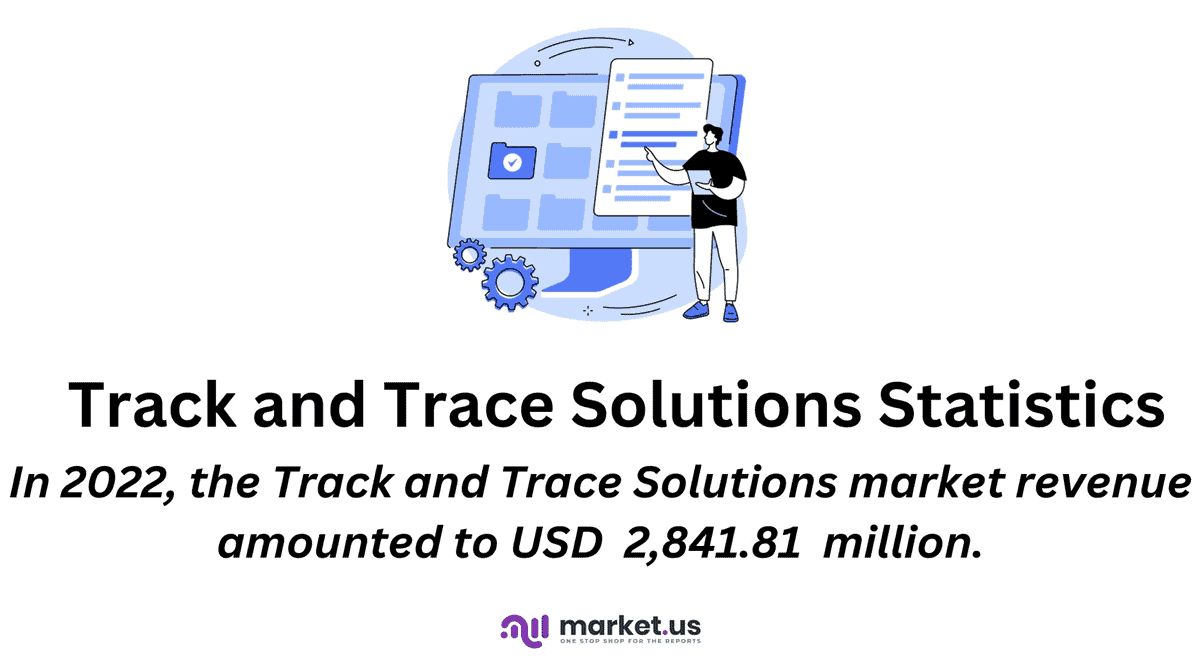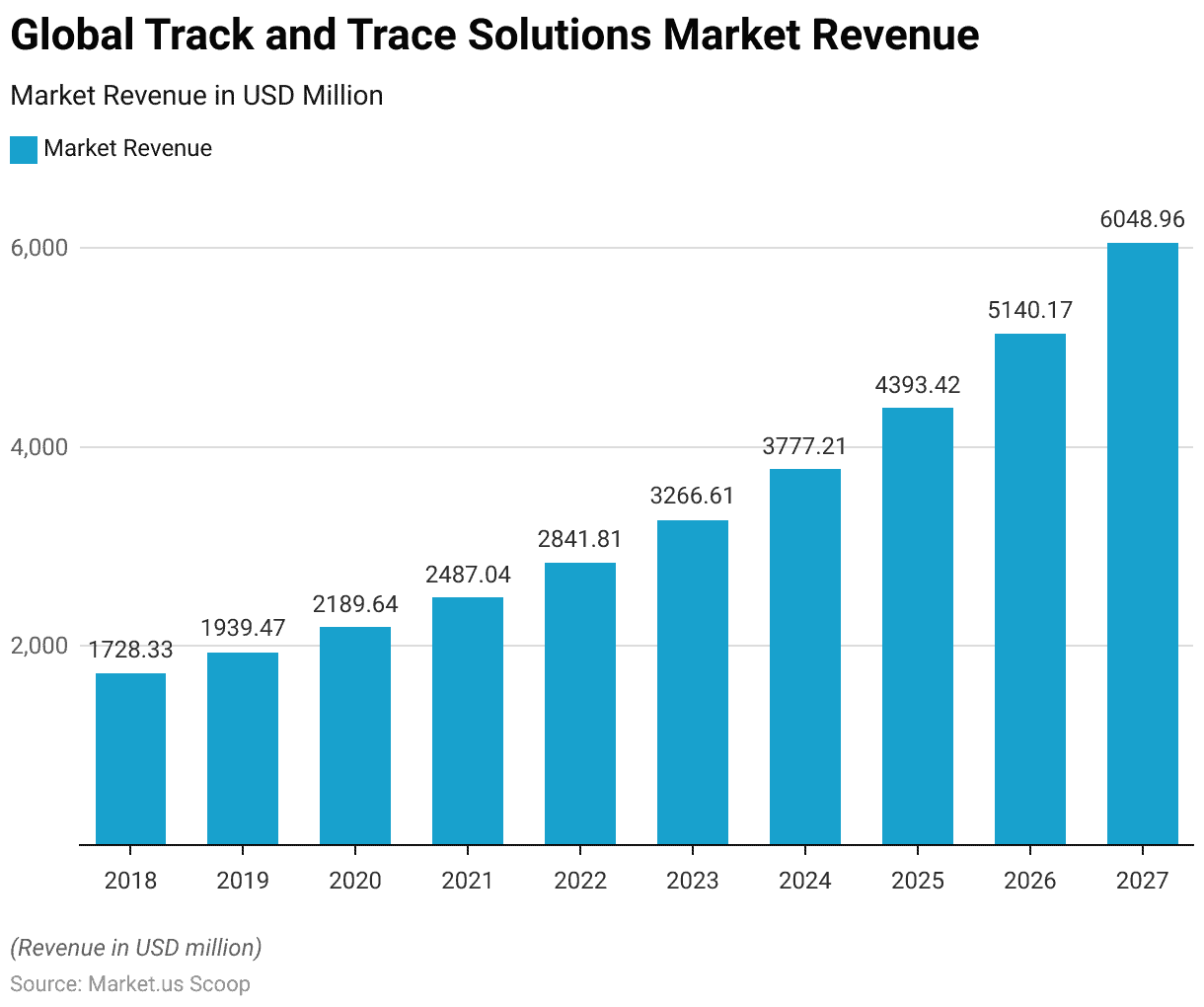Table of Contents
Introduction
According to Track and Trace Solutions Statistics, Track and trace solutions are essential in supply chain management, ensuring product safety, regulatory compliance, and efficiency. They employ technologies like barcodes, RFID, serialization, and data matrix codes to track items in industries such as pharmaceuticals, food, automotive, electronics, and healthcare.
Compliance with regulations is crucial, with standards like the U.S. DSCSA and EU FMD in place. Challenges like data security are met with advancing technology and industry standards, making these solutions indispensable for transparency and efficiency across sectors.

Editor’s Choice
- In 2018, the global track and trace solutions market revenue stood at USD 1,728.33 million and is expected to expand to 6,048.96 million in 2027.
- Barcodes come in various formats, including 1D barcodes like Code 39 and Code 128, as well as 2D barcodes like Data Matrix and Quick Response (QR) codes.
- The first RFID tag was patented in 1973, IBM introduced the first Ultra-High Frequency (UHF) reader in the 1990s, and by 2004, Walmart, a prominent player in the American retail industry, had invested nearly $500 million in its RFID initiatives.
- A data matrix is a 2D barcode composed of black and white cells arranged in square or rectangular modules. The encoded data’s length depends on the matrix’s cell count, ranging from several bytes to 1556 bytes or up to 2335 alphanumeric characters.
- Complying with global pharmaceutical regulations is growing increasingly intricate, with approximately 80% of countries incorporating serialization to combat counterfeit drugs and fraud.
- Global regulatory bodies such as the FDA, EMA, and regional agencies have implemented strict directives that require the use of track and trace technologies for achieving complete visibility, traceability, and responsibility throughout the entire process.
- About 39% of companies are using these tools for demand forecasting, resulting in reduced inventory levels by 20-30%.
Global Track and Trace Solutions Market Overview
Global Track and Trace Solutions Market Size
- The global track and trace solutions market has been on a consistent growth trajectory over the past decade.
- In 2018, the market revenue stood at USD 1,728.33 million, and it continued to expand in subsequent years.
- In 2023, the market is expected to reach USD 3,266.61 million, followed by USD 3,777.21 million in 2024 and USD 4,393.42 million in 2025.
- By 2026, the market is anticipated to surpass the USD 5 billion mark, reaching USD 5,140.17 million, and it is forecasted to continue its upward trajectory, reaching USD 6,048.96 million in 2027.

Technologies Used in Track and Trace
Barcode Systems
- Since the initial scanning of the first consumer barcode in 1974, the application of barcodes for asset tracking has been a game-changer, significantly enhancing data precision and speeding up inventory control for businesses.
- The integration of advanced asset tagging technology and cloud-based asset-tracking solutions has further expanded the utilization of barcode labels and scanning devices within enterprises.
- This adoption has been so extensive that GS1, a global standards organization, approximates that over five billion barcodes are scanned daily, underlining their ubiquity in both consumer and business domains.
- Barcode asset tracking provides a straightforward and cost-effective solution for businesses of all sizes to efficiently manage and monitor their physical assets. This method relies on two essential components: a barcode label and a scanning device.
- Barcodes come in various formats, including 1D barcodes like Code 39 and Code 128, as well as 2D barcodes like Data Matrix and Quick Response (QR) codes.
Radio-Frequency Identification (RFID)
- The utilization of Radio-frequency identification (RFID) for tracking physical objects is not a recent innovation. The origins of RFID tracking systems can be traced back to the Second World War when they were employed to track and identify enemy aircraft.
- Over the subsequent 80 years, RFID technology has undergone significant development. The first RFID tag was patented in 1973, IBM introduced the first Ultra-High Frequency (UHF) reader in the 1990s, and by 2004, Walmart, a prominent player in the American retail industry, had invested nearly $500 million in its RFID initiatives.
- This substantial investment by Walmart served as a signal to all consumer-oriented organizations with substantial assets to recognize the potential of RFID technology and leverage its benefits.
- Since its inception, RFID asset tracking has found application across a wide spectrum of industries and enterprises. Whether in manufacturing facilities, educational institutions, retail establishments, or storage facilities, its tracking functionalities are pervasive and in use across diverse sectors.
Serialization
- Serialization involves assigning a specific code to each product, giving it a unique identity for constant tracking and tracing throughout its lifecycle in production, logistics, and marketing.
- Track and Trace systems follow a hierarchical model consisting of five interconnected levels.
- Level 1 oversees the hardware within production machinery for serialization and aggregation.
- Level 2 manages the serialization/aggregation system across the production chain, with one Level 2 overseeing multiple Level 1 systems.
- Level 3 handles the serialization/aggregation system at the production plant level, with one Level 3 managing multiple Level 2 systems.
- Level 4 manages the serialization/aggregation system at the company level, overseeing multiple Level 3 systems.
- Level 5 oversees the serialization/aggregation system at an external level, facilitating external data access for entities like drug agencies and logistics operators. Typically, Level 5 receives data from a single Level 4.
Data Matrix
- A data matrix is a 2D barcode composed of black and white cells arranged in square or rectangular modules. The encoded data’s length depends on the matrix’s cell count, ranging from several bytes to 1556 bytes or up to 2335 alphanumeric characters.
- Data matrices are commonly applied to label small items because their 2-3 mm² space can hold up to 50 characters of data and still be read with just a 20% contrast ratio. This is especially advantageous for medical packaging as it allows for swift product tracking using barcode readers.
- Data matrices excel in storing data within tiny spaces, with the smallest size being 10×10 modules, compared to QR codes’ 21×21 minimum dimensions.
- They boast a higher error correction rate of around 33% in each version, surpassing QR codes. This makes them the top choice for reliable data coding needs.
Regulatory Compliance
- Complying with global pharmaceutical regulations is growing increasingly intricate, with approximately 80% of countries incorporating serialization to combat counterfeit drugs and fraud.
- Nations like the US, Brazil, EU, Russia, Bahrain, China, and South Korea have distinct serialization mandates, and more countries are expected to adopt similar requirements.
- Meeting these regulations is crucial for patient safety and competitiveness. It demands a robust technology suite, efficient data collection, and secure communication with national track and trace systems to swiftly exchange data.
- Global regulatory bodies such as the FDA, EMA, and regional agencies have implemented strict directives that require the use of track and trace technologies for achieving complete visibility, traceability, and responsibility throughout the entire process.
The Role of Track & Trace Technologies
Quality Assurance
- Imagine your favorite chocolate bar melting in a hot delivery truck or an asthma inhaler losing its potency due to cold conditions.
- These scenarios emphasize the crucial necessity for precise monitoring of temperature, humidity, and light during transportation.
- This is especially vital for perishable items, life sciences products, and delicate electronics, where maintaining the appropriate environment is fundamental for safety and quality.
- Consider the significant impact on food and pharmaceuticals: The International Air Transport Association (IATA) notes that 25% of vaccines lose their efficacy due to improper shipping, and around 5 to 20% of temperature-sensitive vaccine shipments degrade during transit.
- In the U.S., food waste amounts to a staggering 400 pounds per person each year, incurring roughly $218 billion in costs.
- Simultaneously, foodborne illnesses affect 48 million individuals annually in the United States.
Safety & Security
- When it comes to shipping hazardous materials, the stakes are exceptionally high, and tracking technology plays a crucial role.
- In 2022, there were 23,178 hazmat incidents on highways, resulting in $21.3 million in damages.
- Additionally, the Coalition to Prevent Chemical Disasters documented 188 incidents, with over 30 more occurring in the first seven weeks of 2023.
- This underscores the importance of real-time tracking technology, especially since only 37% of companies effectively monitor their hazardous shipments in transit, even though approximately 84% of incidents involving these materials happen during transportation.
Data-Driven Decision Making
- Predictive analytics and data analysis are revolutionizing supply chain management.
- About 39% of companies are using these tools for demand forecasting, resulting in reduced inventory levels by 20-30%.
- Maintenance, asset management, and customer transparency also benefit, with 35% of companies applying analytics in these areas.
- Supply planning and pricing optimization are similarly influenced, and utilized by 32% and 31% of companies, respectively.
Discuss your needs with our analyst
Please share your requirements with more details so our analyst can check if they can solve your problem(s)



